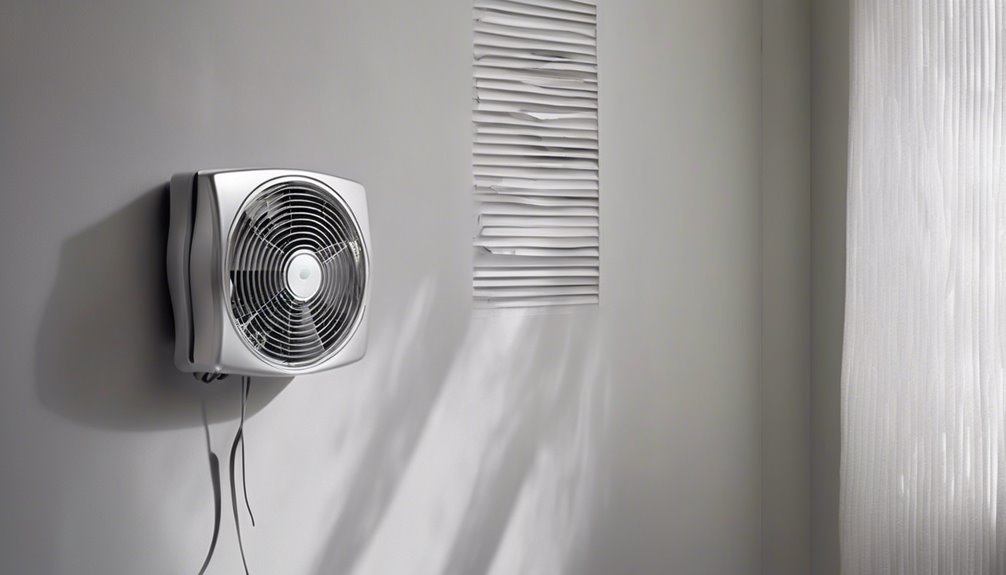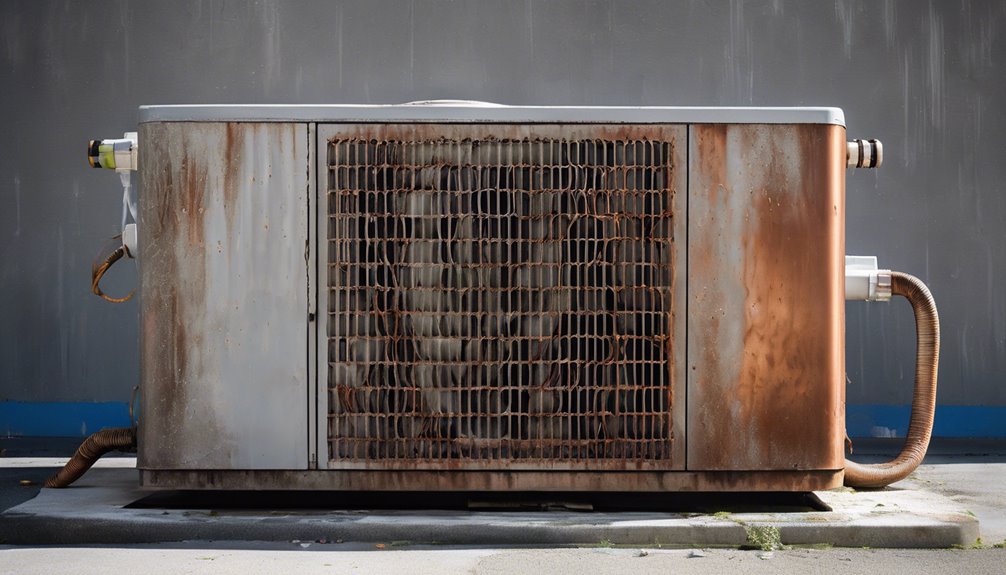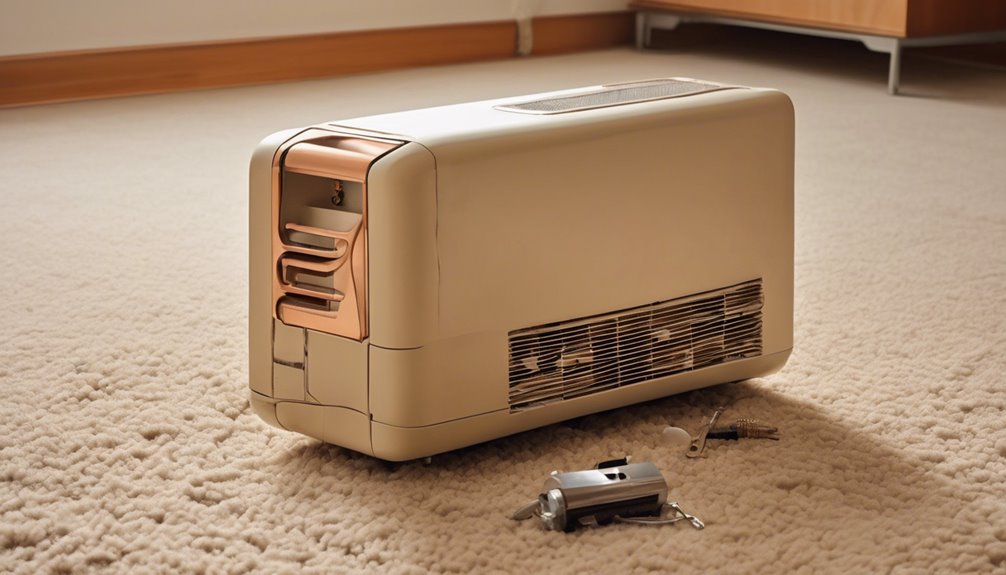If your AC fan isn't blowing air properly, it's likely due to a faulty or dirty air filter, blocked or restricted airflow, or a malfunctioning fan motor or capacitor. You might also have frozen or dirty condenser coils, loose or faulty fan belts, or refrigerant leaks or low levels. Electrical issues, like tripped circuit breakers or blown fuses, and improperly installed or leaky ductwork could be the culprit too. To get to the root of the problem and prevent further issues, take a closer look at these potential causes and explore the possible solutions.
Key Takeaways
- A dirty or faulty air filter is often the primary cause of an AC fan not blowing air properly, reducing air circulation and increasing energy bills.
- Blocked or restricted airflow can be caused by clogged condenser coils, bent or crushed fins, or improperly installed or leaky ductwork, leading to reduced cooling performance.
- Faulty fan motor or capacitor, loose or worn-out fan belts, and refrigerant leaks or low levels can also impede airflow and affect the AC's performance.
- Incorrect thermostat settings, calibration, or mode can prevent the AC fan from blowing air properly, and seasonal changes can also impact its performance.
- Regular maintenance, including filter cleaning and coil inspection, is crucial to ensure the AC fan works efficiently and blows air properly.
Faulty or Dirty Air Filter
A dirty or faulty air filter is often the culprit behind an AC fan not blowing air.
You might be wondering why your air conditioner is struggling to circulate air. It's likely because your filter is clogged with dust, dirt, and debris. When was the last time you checked and cleaned your air filter?
Regular filter maintenance is crucial to ensure your AC fan works efficiently. Try removing and washing your filter with soap and water, then letting it dry before reinstalling it. If it's damaged, consider replacing it with a new one.
Blocked or Restricted Airflow
If your AC fan isn't blowing air, you should check for blocked or restricted airflow.
You might be surprised to find that a dirty air filter, clogged condenser coils, or bent or crushed fins are the culprits. These common issues can significantly reduce airflow, so it's essential to inspect and clean or replace them as needed.
Dirty Air Filter
Your AC fan's failure to blow air can often be traced back to a dirty air filter, which blocks or restricts airflow.
A dirty filter reduces air circulation, causing your AC fan to work harder and increase your energy bills. To avoid this, you need to prioritize filter maintenance.
You can identify the need for filter maintenance by looking out for the following signs:
- You notice a significant decrease in airflow from the vents
- Your AC fan is making strange noises or vibrating excessively
- Your energy bills are higher than usual
- The filter is visibly dirty or clogged with debris
- You haven't replaced the filter in a while
Regular filter replacement can solve this issue. Make it a habit to check and replace your air filter every 1-3 months, depending on usage and manufacturer's recommendations.
Clogged Condenser Coils
Since your AC fan isn't blowing air, it's essential to inspect the condenser coils, as clogged or blocked coils can significantly restrict airflow.
You'll want to check if debris, dirt, or vegetation is obstructing the coils. If you find any blockages, clean the coils using a garden hose or a specialized coil cleaning brush.
Regular coil maintenance is crucial to ensure your AC operates efficiently. Neglecting coil cleaning can lead to increased energy bills, reduced airflow, and even system failure.
Make coil cleaning a priority to prevent these issues. Remember, a clean condenser coil is key to optimal airflow and a well-functioning AC system.
Bent or Crushed Fins
Bent or crushed fins on your AC's condenser coils can significantly impede airflow, leading to reduced cooling performance and increased energy bills.
This finned obstruction creates an airflow restriction that hampers your AC's ability to cool your home efficiently.
Check for bent or crushed fins by inspecting the condenser coils.
Look for signs of damage, such as:
- Dented or creased fins
- Fins that are touching or overlapping
- Fins with rust or corrosion
- Fins that are bent at an angle
- Fins with debris accumulation
Frozen or Dirty Condenser Coils
If your AC fan isn't blowing air, frozen or dirty condenser coils might be the culprits.
You'll need to inspect the coils to determine the issue. When inspecting the coils, look for signs of frost buildup or dirt accumulation.
Check for any blockages, such as leaves or debris, that might be obstructing airflow.
If you find the coils are dirty, you can clean them using a garden hose or a specialized coil cleaning brush.
Coil cleaning methods may vary depending on the type of coil and the level of dirt buildup.
Make sure to follow the manufacturer's instructions for cleaning and maintenance to ensure your AC fan is working efficiently.
Loose or Faulty Fan Belts
One common culprit behind an AC fan not blowing air is a loose or faulty fan belt.
You mightn't think about it, but a faulty belt can significantly reduce airflow.
A faulty belt can significantly reduce airflow, making it a crucial component to inspect when troubleshooting AC fan issues.
If you suspect this is the issue, inspect the belt and its components.
Look for signs of wear, cracks, or misalignment.
- Check for worn pulleys, which can cause the belt to slip or vibrate excessively
- Verify that the belt is properly seated on the pulleys
- Inspect the belt tensioning system to ensure it's functioning correctly
- Look for signs of belt wear, such as cracks or fraying
- Check the belt's alignment with the motor and fan pulleys
Malfunctioning Fan Motor or Capacitor
Since the fan belt seems to be in good condition, you'll want to investigate the fan motor and capacitor as the next possible culprits behind your AC fan's lack of airflow.
Motor failure can be a common issue, especially if the motor is old or has been working overtime. Check for signs of wear and tear, such as rust, corrosion, or unusual noises. If you suspect motor failure, it may be time to replace the motor entirely.
Additionally, capacitor issues can also cause airflow problems. Capacitors help regulate the motor's voltage, so if they're faulty, the motor won't function properly. Look for signs of capacitor failure, such as burning smells or bulges on the capacitor itself.
Tripped Circuit Breaker or Blown Fuse
Your AC fan's lack of airflow could also be attributed to a tripped circuit breaker or blown fuse.
This is often caused by a circuit overload or electrical surge, which can happen when multiple appliances are plugged into the same circuit or during a power outage.
Circuit overloads and electrical surges can occur when multiple appliances share a circuit or during power outages.
Check your circuit breaker or fuse box to see if the breaker has tripped or a fuse has blown. If so, you may need to reset the breaker or replace the fuse.
- The fan won't turn on at all
- The fan is making a humming or buzzing noise but not spinning
- The fan is spinning slowly or intermittently
- You've recently experienced a power outage or electrical storm
- You've added new appliances to the same circuit
Improperly Installed or Leaky Ductwork
Faulty ductwork can be a significant contributor to your AC fan's lack of airflow.
If your ducts are improperly installed or leaky, it can restrict airflow, causing your fan to work harder and reducing its overall performance.
You should inspect your ductwork to identify any gaps, cracks, or loose connections. Apply duct sealant to seal any leaks or gaps you find.
A thorough ductwork inspection can help you identify areas that need improvement. By sealing your ducts, you can improve airflow and increase your AC fan's efficiency.
Refrigerant Leaks or Low Refrigerant Levels
Refrigerant leaks or low refrigerant levels can be another culprit behind your AC fan's inability to blow air.
If your refrigerant is leaking or running low, it can cause your AC's cooling capacity to drop, leading to reduced airflow.
Here are some signs you might've a refrigerant issue:
- Your AC is blowing warm air or not cooling your space effectively
- You notice ice buildup on the coils or refrigerant lines
- Your energy bills are higher than usual
- You hear hissing sounds or notice refrigerant leaks around the unit
- Your AC's refrigerant pressure is lower than recommended during a refrigerant inspection
Get a professional to inspect your AC's refrigerant system to identify and fix any leaks or low levels.
They'll check the refrigerant pressure and perform a thorough inspection to get your AC fan blowing air properly again.
Thermostat Issues or Incorrect Settings
If your AC fan isn't blowing air, you should check your thermostat settings to ensure they're correct.
You might be surprised to find that a simple incorrect temperature setting is the culprit. Additionally, a malfunctioning thermostat component could be preventing your fan from working properly.
Incorrect Temperature Setting
Your AC fan not blowing air might be due to a simple mistake – an incorrect temperature setting.
This issue is often overlooked, but it's essential to ensure your thermostat is set correctly. If it's not, your AC fan won't blow air properly.
- Incorrect calibration: The thermostat's temperature reading doesn't match the actual room temperature.
- Temperature mismatch: The thermostat is set to cool, but the temperature is already lower than the set point.
- Setting the thermostat too high: If the thermostat is set too high, the AC won't blow air.
- Failing to adjust for seasonal changes: Forgetting to change the thermostat settings for winter or summer can affect the AC's performance.
- Not accounting for humidity: High humidity can make the AC work harder, leading to reduced airflow.
Malfunctioning Thermostat Component
Since the thermostat plays a crucial role in regulating your AC's performance, a malfunctioning thermostat component can easily cause your AC fan to stop blowing air.
If your thermostat isn't calibrated correctly, it can lead to temperature fluctuations, which can affect your AC's ability to blow air properly. Check if your thermostat is functioning correctly by ensuring it's set to the correct mode (cooling or heating) and that the temperature is set low enough to trigger the AC to turn on.
If you're still unsure, consider replacing the thermostat or consulting a professional to diagnose and fix the issue. A faulty thermostat can be a simple fix, but it can have a significant impact on your AC's performance.
Frequently Asked Questions
Can I Clean My AC Fan Blades for Better Airflow?
You can absolutely clean your AC fan blades to improve airflow! Over time, dust accumulation on the blades causes air obstruction, reducing circulation. Give them a gentle wipe with a soft brush or cloth to remove dirt and debris, and you'll be breathing easier in no time!
Will a Dirty AC Exterior Affect Its Performance?
You're wondering if a dirty AC exterior affects performance. Yes, it can! Dust accumulation on the exterior coils reduces airflow, while filter blockage increases pressure, making the AC work harder and decreasing its efficiency.
Can I Use a Regular Fan to Supplement My AC?
You can use a regular fan to supplement your AC by placing it strategically to enhance air circulation. Position it to blow cool air towards you or circulate it around the room to maximize its effectiveness.
How Often Should I Inspect My AC for Issues?
You should inspect your AC regularly, ideally during seasonal checks, to catch potential issues early. Don't forget to prioritize filter maintenance, as a dirty filter can lead to reduced airflow and decreased efficiency.
Can I Fix AC Fan Issues on My Own or Hire a Pro?
You can try fixing issues yourself, but if you're unsure, it's best to hire a pro. Faulty motor or worn bearings might require professional expertise to diagnose and replace, saving you time and ensuring a proper fix.
Conclusion
You've checked all the possible causes for your AC fan not blowing air properly. If you've cleaned or replaced the air filter, ensured airflow isn't blocked, and inspected the condenser coils, fan belts, and motor, but the issue persists, it may be time to call a professional. Don't forget to check the thermostat settings and circuit breaker before seeking help. Remember, ignoring the problem can lead to more costly repairs or even system failure.



